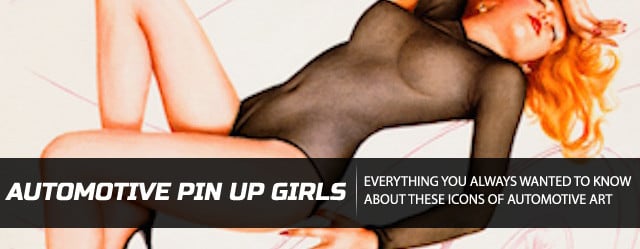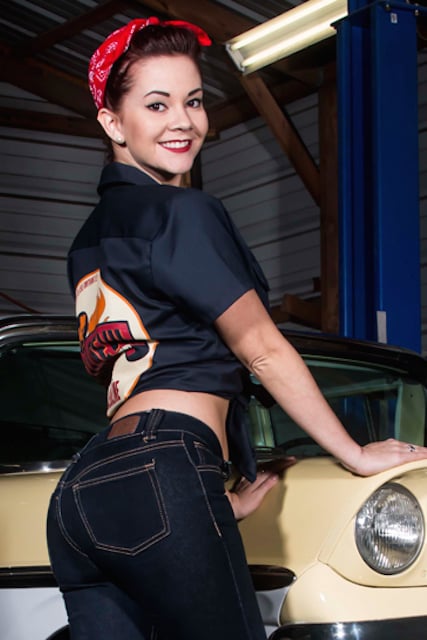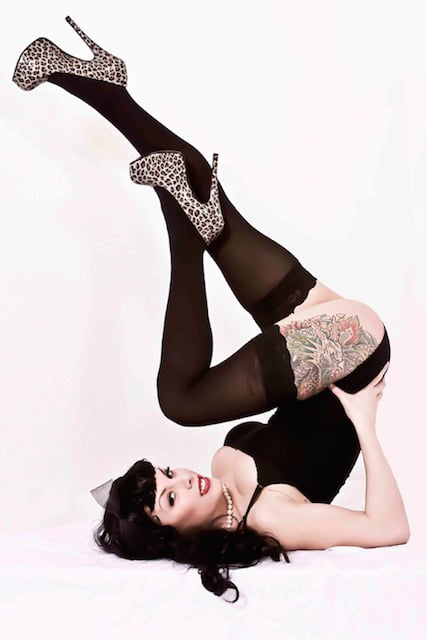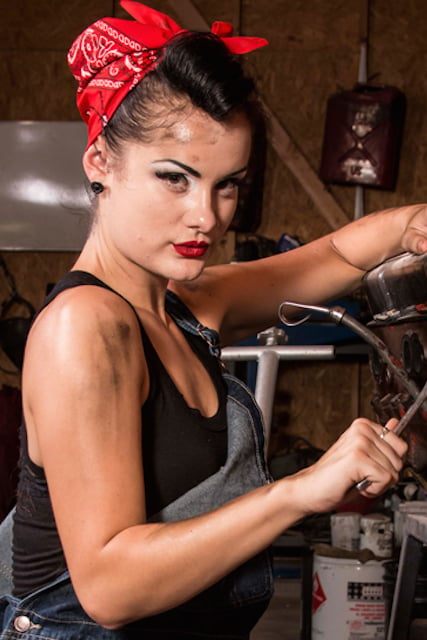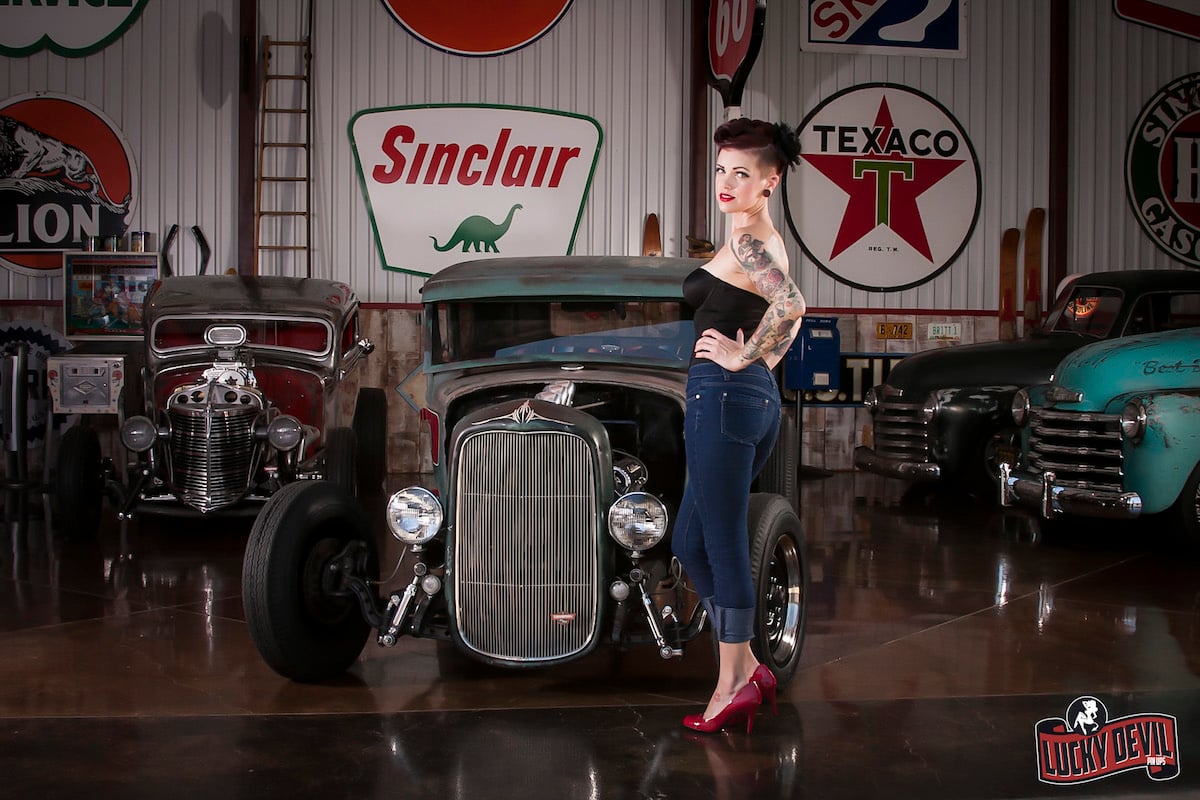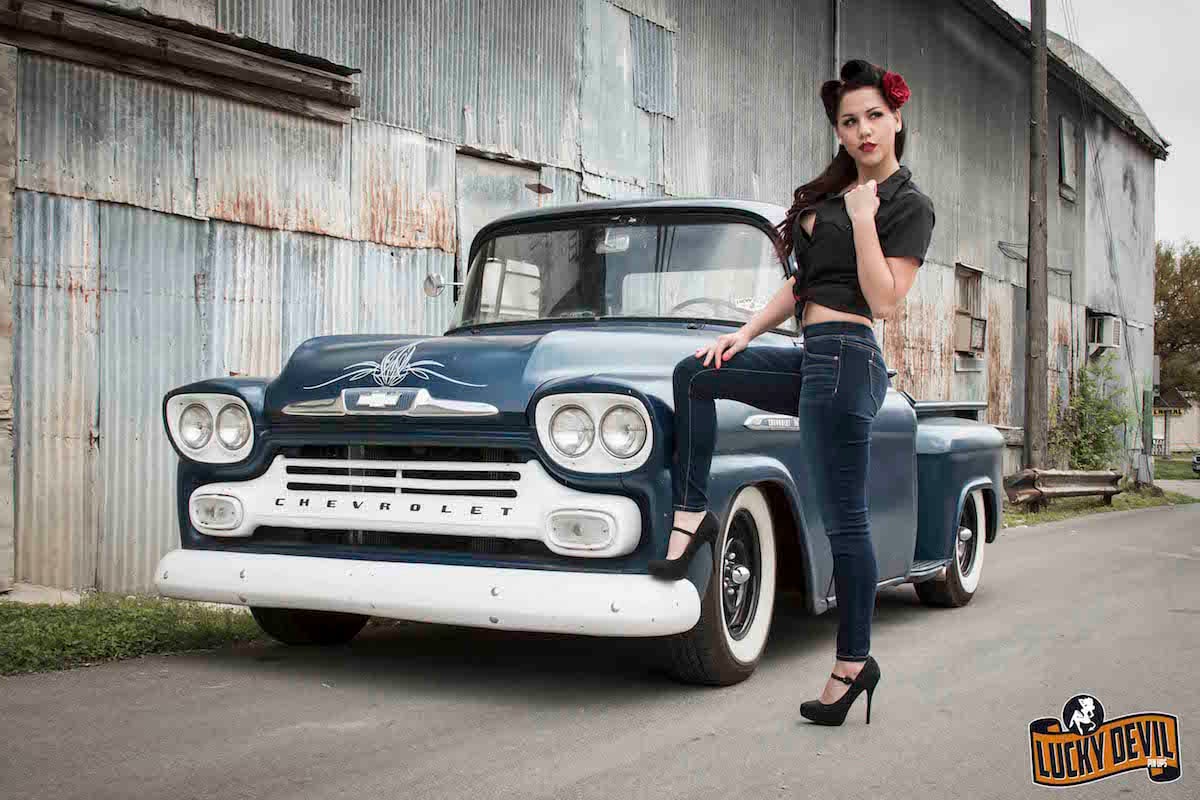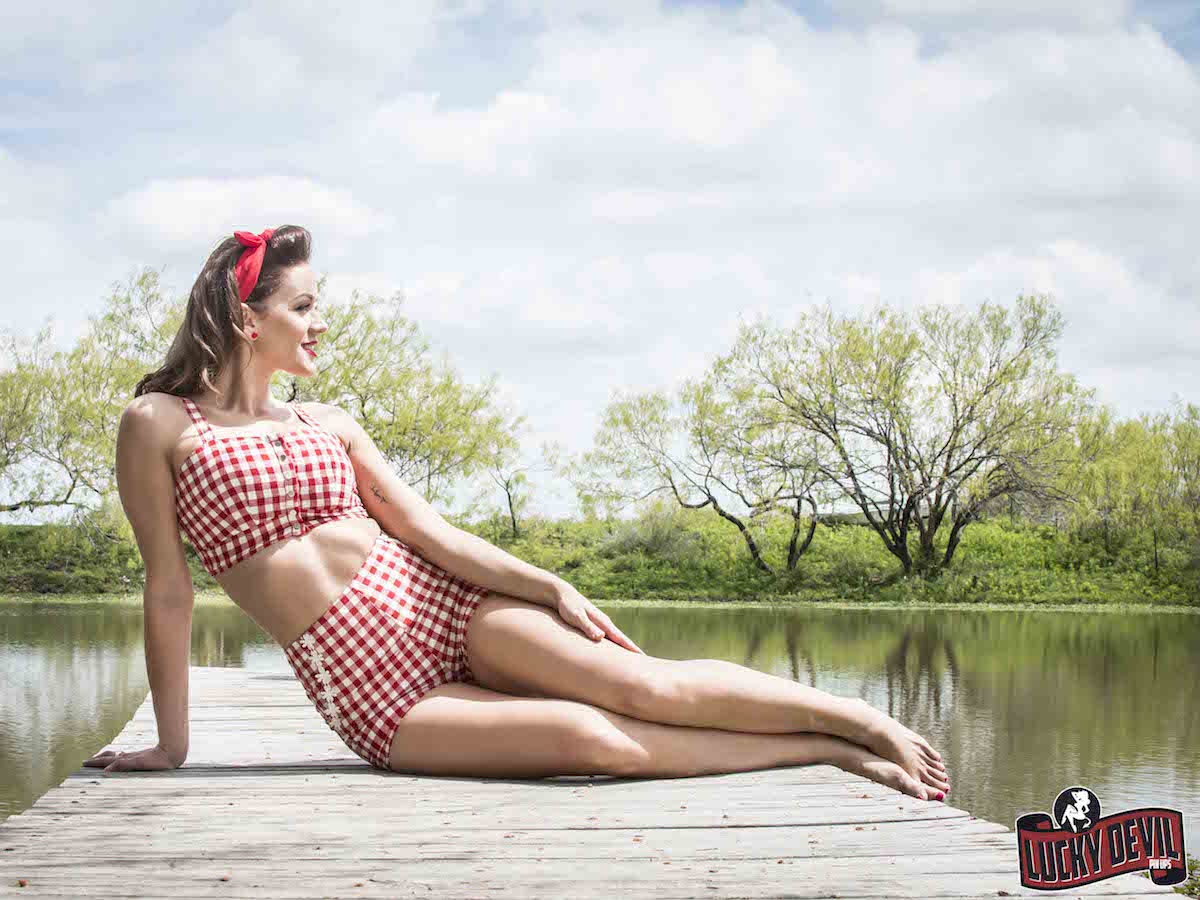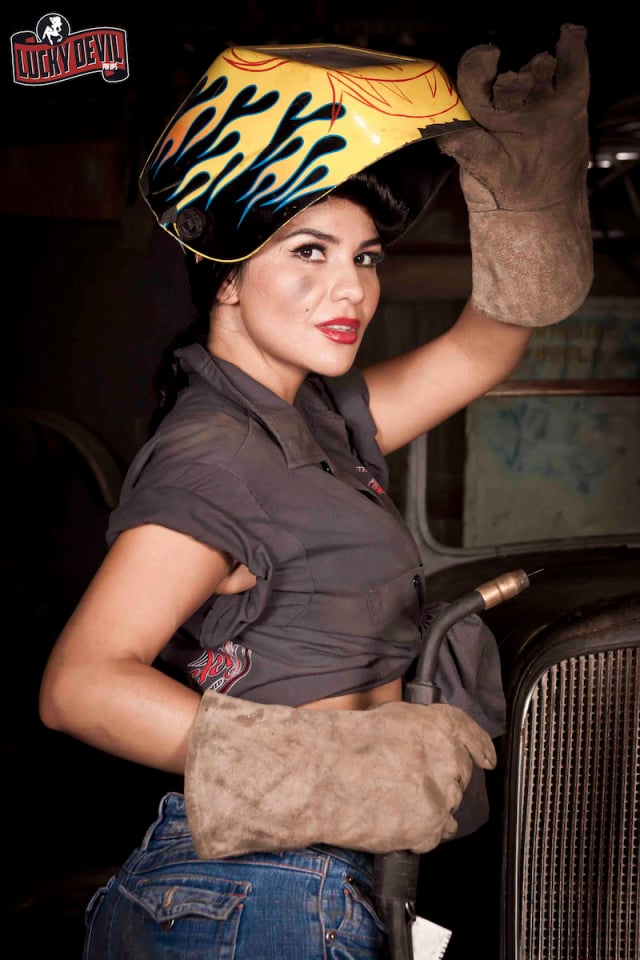On the whole, pin up girls have been around longer than you might think. Given that the automobile is a fairly recent invention, and considering the entire history of mankind, it is little wonder that automotive pin up girls only gained real prominence in the 1950s. One could argue that if cars had been around when Sandra Botticelli painted “The Birth Of Venus,” instead of a sea shell, Venus might have been born out of a Chevy.
If you go to a circus, you expect to see a girl on a trapeze. When you go to a vintage car show, you expect to see a pin up girl. – Adam Marmolejo
A Short Pin Up History Class
The real origin of pin up girls modeling next to wheels is unknown but there are a lot of advertisements from the late 1800s of women posing next to safety bicycles. These safety bicycles had both tires of the same size and replaced the Penny-Farthing bicycles, the older bicycles that had one large solid front tire and a smaller rear tire. The Penny-Farthing bicycles were unbalanced and had hard wheels made of wood or metal, which were unsafe and uncomfortable to ride. The advent of the pneumatic wheel on the newer safety bikes (lower center of gravity with equal size wheels), made it a popular choice with women. In those days, clergy and medical professionals were against women riding bicycles, claiming the bouncing damaged their fragile insides. These professionals also worried that the friction caused by the seat would result in their arousal. Pin up posters warning of these hazards were tacked up in all the popular men’s gathering spots.
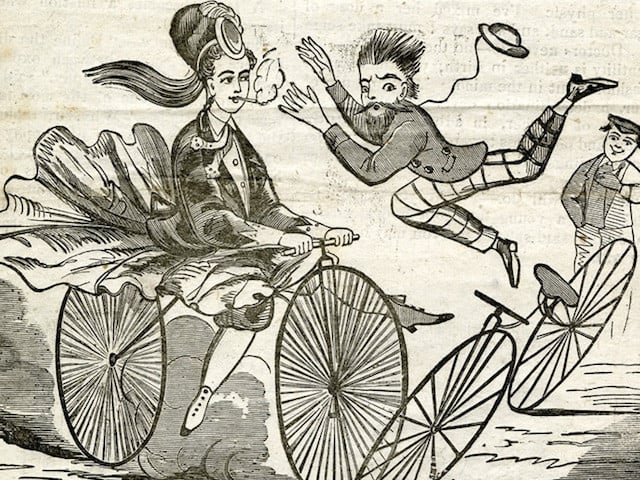
To prevent women from becoming too independent and driving bicycles in the late 1800s, clergy and medical professionals came up with all kinds of tragic ailments that would befall these skin-baring she-daredevils. Illustration from www.pilcrowmagazine.com
Despite these claims, women jumped at the chance to ride these two-wheeled machines and enjoyed the independence offered of getting around without having men as escorts. Wardrobes began to change to meet the new form of transportation, and women began to appear on posters and advertisements for bicycles. Looking back, these advertisements are probably the first real indication that sex appeal sells vehicles.
In 1889, two college friends introduced art into modern calendars. From a print of the Montgomery County Courthouse in Red Oak, Iowa, calendar art was marching toward the inevitable – women on calendars. By the time a calendar featuring women selling products reached the market in 1903, the women’s suffrage movement was heating up and quickly changing cultural acceptance and views of women in society.
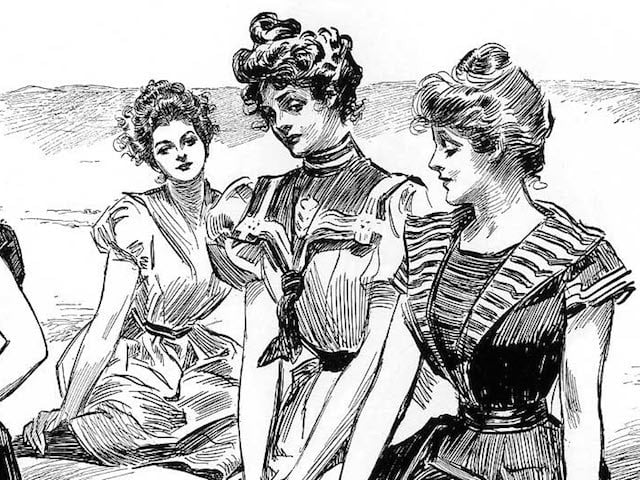
Life magazine’s Gibson Girl defined the early pin up girl. Photo from www.wikimedia.org
Life magazine’s “Gibson Girl” defined artistic pin ups by promoting a womanly perfection with an hour-glass shape, full lips, and billowy thick hair at the turn of the century. This continued to be the standard for pin up girls until World War I. Posters with this new idealism were created to inspire patriotism, and as a tool to recruit new soldiers, by featuring women dressed in military uniforms.
This style of pin up art continued through WWI and into the roaring twenties when artists started to show a bit more skin in their artwork, which fit with the changing times and the modern “flapper” girls. The Great Depression era put a stop to non-essential items consumers once had an income for, which in turn saw a demise of pin ups and calendars until the outbreak of WWII. Again, banking on women to inspire patriotism and show men what they were fighting for back home, pin up girls and the posters of this era hit an all-time high — and remain popular today.
Lucky Devil Pin Ups
Adam Marmolejo started Lucky Devil Pin Ups a decade ago when he took up photography in a serious fashion. Once he became confident in his skills, Marmolejo focused on an area that was popular when he was growing up, pin up photography and hot rods.
He came up with the name Lucky Devil, just joking around that he was a Lucky Devil to be able to photograph beautiful women, but the name stuck and his brand evolved. He wants to be known as a photographer of all types of pin ups, not just a particular era, but pin ups as a whole.
Realizing that sex worked in war advertising, the automotive industry was quick to capitalize on the pin up theme. Advertisers understood that sex sells. With the industrial revolution in full swing, the 1950s became the pinnacle for pin up art.
Automotive Pin Up Art
“When the war was over and you had all these soldiers coming back, hot rods became their adrenaline outlet. They had these ’40s Fords and the guys would make them lean and make them fast,” offered Marmolejo. “That’s when you got the car culture blending with the military power culture. The guys would hang out and soon enough, the girls started coming around, too. A guy with a great hot rod simply wanted to go cruising around with a beautiful girl.
“This was also the time when women became empowered,” Marmolejo noted. “They were no longer trapped in their homes. They were building our planes and our ships. They were working in the factories. They weren’t going to settle for less anymore. So much of the 1950s hot rod culture came from the war era. The nose art, pin up girls, bomber seats, and speed.”
Modern pin ups still pay homage to the classic 1940s pin up style.
While the guys started wrenching on their cars, many times using surplus war goods, the women were just as busy working on their style. “These girls started to imitate the pin up girls of the great artists like Vargas and Elvgren,” claimed Marmolejo. “Women would see these pin ups and they started dressing up to that style. It became intertwined with the hot rods and became a culture all of its own.”
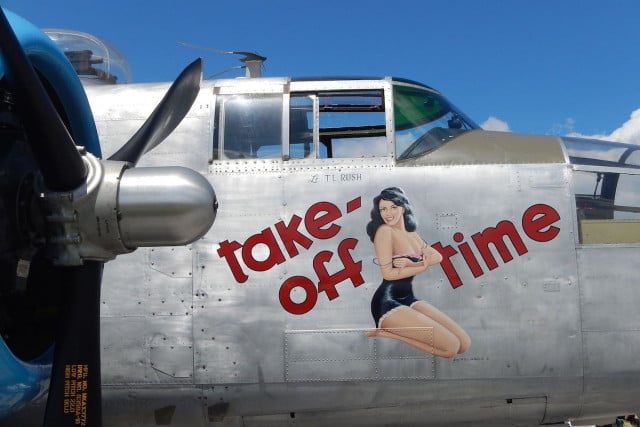
The popularity of pin up girls exploded during World War II beginning with bomber nose art. Photo from wikimedia commons
While not necessarily automotive art, trophy queens made their presence known from the very early days of racing. “There were trophy queens at car races back in the day, but pin ups were typically thought of as actresses that were on posters and hung up on the wall,” explained Marmolejo. “Having these women around hot rods and race cars promoted the art. It wasn’t a race unless a pretty girl was holding the flag.”
Pin Ups Today
To understand how pin ups have evolved, we need to understand what the definition of a traditional pin up girl is. According to several sources, a classic pin up girl is a model whose mass-produced pictures had wide appeal in pop culture. These pictures were intended to be informally displayed, or pinned up on a wall or bulletin board and were almost never framed. Marmolejo defines the classic pin ups as either “Sandy or Rizzo from ‘Grease.’”
 In today’s digital media age, pin ups have a broader range. No longer do women need to be established models or actresses to start working as a pin up. The traditional look isn’t even needed to get into pin up modeling. “I think what works for pin ups in today’s society is the different looks,” stated Marmolejo.
In today’s digital media age, pin ups have a broader range. No longer do women need to be established models or actresses to start working as a pin up. The traditional look isn’t even needed to get into pin up modeling. “I think what works for pin ups in today’s society is the different looks,” stated Marmolejo.
“It’s not the pin up of the 1930s and ’40s. It has transitioned to something broader. There is a classy, a trashy, and something in between. I think that is exactly what makes it work today,” he said. “You can have a girl that has no tattoos, and a classic look, and people are drawn to it. Then you can have another girl that is covered in tattoos, with a pin up look, and a different group of people are drawn to it.”
There is no doubt that pin ups change over time. Stephen King’s Shawshank Redemption is a perfect example how pop culture changed pin ups over time. Hapless prisoner Andy Dufresne hid his escape tunnel with a popular Rita Hayworth poster. Next came the equally popular pin up of Marilyn Monroe, and the movie ended with Raquel Welch’s famous 1960s pin up.
Pin up girls and car shows have become so intertwined over the years. Marmolejo reminded us: “If you go to a circus, you expect to see a girl on a trapeze. When you go to a vintage car show, you expect to see a pin up girl.”
Lucky Devil Pin Ups' models include (clockwise from top left): Ruby Franco, Nikki Riot, Angie Walls, and April Ames.
Pin up art and the pin up girls have continued to evolve into the fantastic automotive artwork that we enjoy today. From the classic style to a sassy rockabilly look, all the way to a hardcore trashy aura. There are fans for each style type, with many of these models crossing the confines of style boundaries, collecting even more fans.
What Is Next?
“As with anything else, you have to evolve,” Marmolejo stated. “You can go back to the 1980s and there weren’t as many women with tattoos. We see a lot of that now. We have tattoos and piercings that are socially acceptable. It’s only natural that this migrated into photography and automotive art.”
Trying to predict what is going to be the next trend in the social scene is almost impossible, but Marmolejo believes that attire is the next frontier. “Clothes! It is just my opinion because if I knew what the next popular trend was going to be, I’d set that trend and everyone would be talking about Lucky Devil Pin Ups,” he said laughingly.
“Hairstyles have remained pretty constant,” he adds. “You see changes in clothing over the years. I don’t know what the next trend in pin up clothing is, but it will happen.”
We don’t know what the next trend in pin up clothing will be either. No matter if it is a style pattern, ornaments, or a certain style of apparel, we will be at the circus looking for the girl on a trapeze.
Adam Marmolejo – and Rod Authority – wanted to send special thanks to Lucky Devil Pin Ups’ models Nikki Riot, Rachelle Razor, Kimber Fox, Jurae, Ruby Franco, Kitty Courtney, Vintage Doll, Dany Bullet, and Jovahna. If our readers end up being lucky devils, we may have full model features of these beautiful women in the future.



